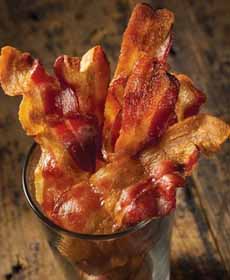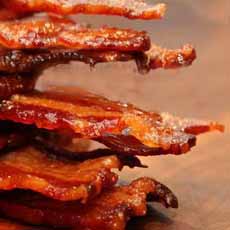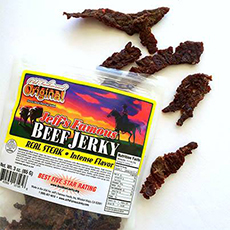GIFT: Jeff’s Famous Jerky, Bacon, Beef Or Turkey
|
|
America’s consumption of meat snacks has increased by 18% over the past five years, according to recent data from The NPD Group, a market research company. And America wants more of this high protein, low-fat, grab-and-go snack that’s naturally gluten-free*. We’ve had Top Pick jerkys before, but they are few and far between. Even small-batch artisan brands can be too tough for us, and/or leave remnants of gristle. Not so with Jeff’s Famous Jerky. Each variety we tried was melt-in-your-mouth tender, with exquisite flavor. When you can say jerky has exquisite flavor, you know you’ve hit the motherlode. Jeff’s Famous Jerky, of Mission Viejo, California deserves to be famous, especially for its eye-opening bacon jerky. Bacon or beef, the meats are marinated in deep, layered marinades. The beef jerky has lower sodium than most brands, with no added MSG or nitrates. The bacon jerky has less sodium than pan-fried bacon. The only caveat with jerky in general is that it’s high in sodium (don’t buy it for anyone on a salt-restricted diet). But it’s almost fat free, and it’s solid protein: One ounce has about 23% of one’s daily value of protein. We don’t like hard, overly chewy jerky. Jeff’s Famous Jerky is so tender and tasty, you can bring it to the dinner table and pair it with fine foods. Jeff’s makes a variety of delicious, tender jerky varieties. You can buy individual packages or a build-your-own box. The flavors are variously spicy, sweet, hot, and combinations thereof. More importantly, they are clean, clear and natural, beautifully layered to imbue the meat with complex flavors. All are hormone-free, without added MSG or preservatives, made from American meats. Bacon Jerky Varieties Single-flavor packages are $6.99 at JeffsFamousJerky.com. The beef packages contain 3 ounces of jerky; the bacon packages have 2 ounces. Build-your-own variety packs offer a 20% savings; and there are gift boxes with personalized notes. DISCOVER MORE AT JEFFSFAMOUSJERKY.COM The word jerky comes from the Quechua language of the Incas, who called their dried meat “charqui.” But they were hardly the first people to make it. Neither were Homo sapiens, we can deduce. Homo erectus emerged 1.5 million years ago, and evidence found five years ago in a South African cave suggests Homo erectus that built campfires. The remains of animal bones and plant ash could be dated to a million years ago. [source] By the time Homo sapiens emerged, 195,000 years ago, man had been enjoying barbecue, and by extension jerky, for some time. |
|
|
Drying food is one of the first three food preservation techniques, along with salting and, in northern climes, packing with snow in ice caves or cellars. Meat dried over a smoky fire is protected from egg-laying insects and multiplying bacteria (they need moisture to live). Cutting it into thin strips makes it easier to chew. While the prehistoric method of drying the meat was used by other ancient peoples, it was not known in Europe. The first visitors to the New World found Native Americans making jerky† from the meat of any animal they hunted (that which wasn’t consumed immediately). In addition to helping early colonists stave off starvation, later pioneers who headed west quickly learned to make jerky. It was easy to transport, and was an important, high-protein addition to their diet. The meat for jerky could be anything from buffalo to whale. Today jerky can be found in proteins as common as turkey, tuna and salmon, to exotics such as alligator and ostrich. Today’s jerky eaters have the luxury of enjoying it as a snack rather than a necessity. We also have the pleasure of using tender cuts of meat marinated in a variety of spices, salt and/or sugar—seasonings that were not available to most ancients jerky-makers. Modern jerky is dried in low-heat smokers, as opposed to the ancient technique of hanging strips of meat racks to dry in the hot sun. (The campfire could hold only so much.) If your only experience with jerky has been dry and tasteless jerky, you deserve some of the good stuff. *Some brands or flavors within brands may use soy sauce or other glutinous ingredient in the marinade. †The pemmican you may have read about in tales of early America was dried meat mixed with dried berries and rendered animal fat. It was invented by Native Americans and used extensively by immigrants in the fur trade. Many years later, it served as a high-calorie food for Arctic and Antarctic explorers such as Robert Falcon Scott and Roald Amundsen.
|
||





